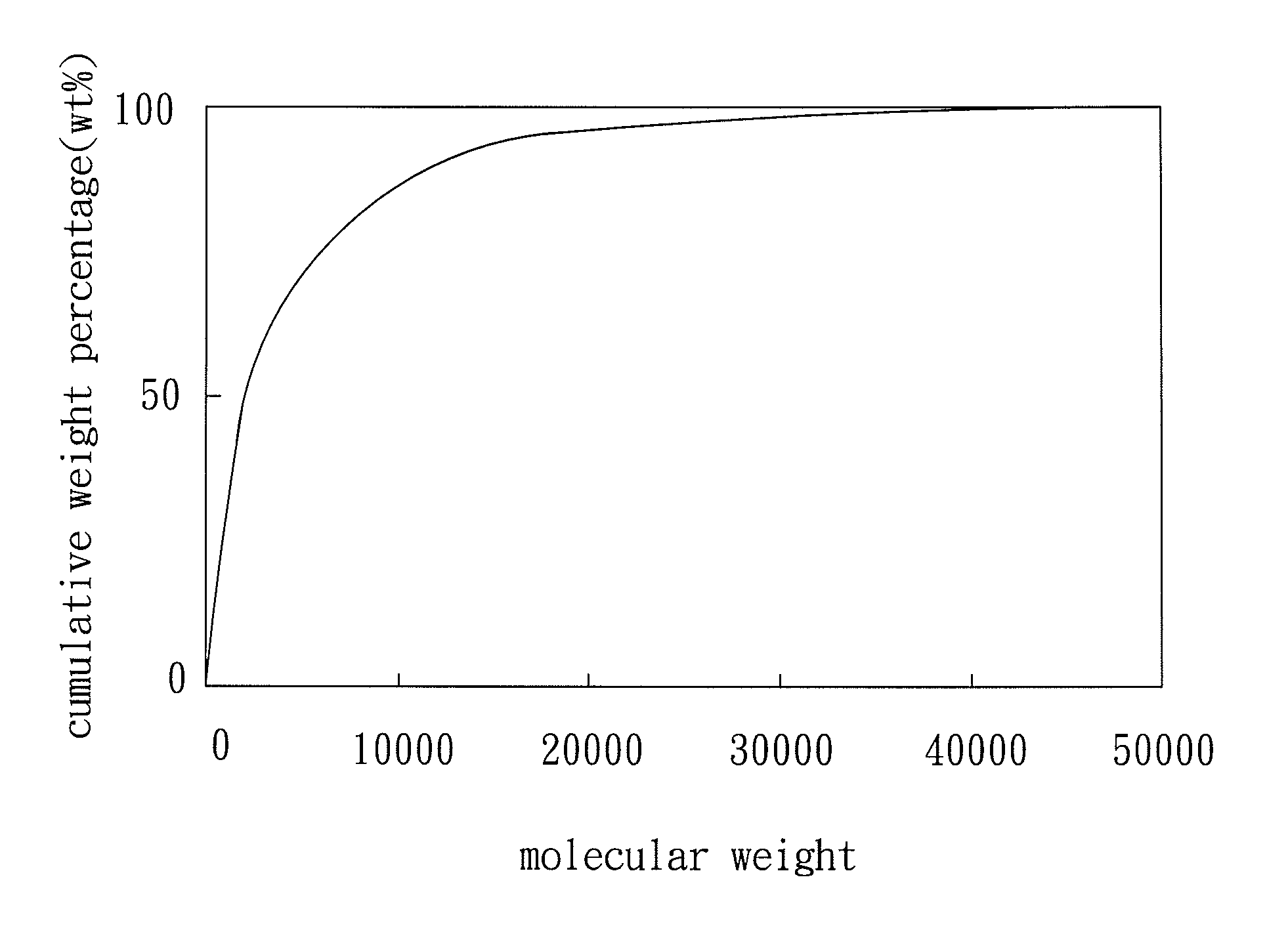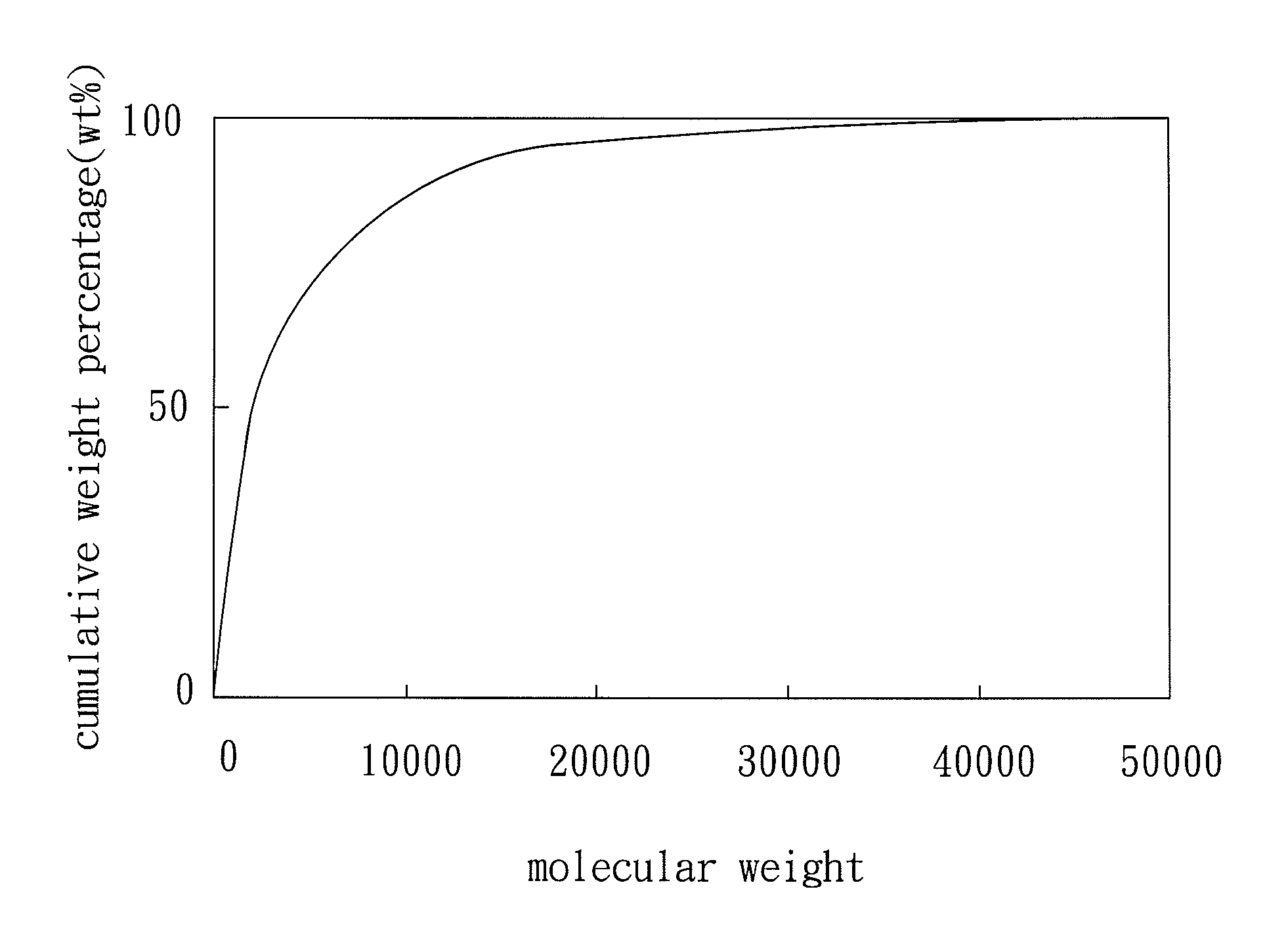Photo-curing polysiloxane composition and protective film formed from the same
a polysiloxane composition and protective film technology, applied in the field of photocuring polysiloxane composition, can solve the problems of pattern reflow problem, inability to develop a positive, conventionally positive polysiloxane-containing material to form a pattern with good fineness, etc., and achieve good developing property and proper softening point
- Summary
- Abstract
- Description
- Claims
- Application Information
AI Technical Summary
Benefits of technology
Problems solved by technology
Method used
Image
Examples
preparation example 1
[0094]A 500 ml three-necked flask was added with dimethyl dimethoxysilane (referred to as DMDMS, 78.0 g, 0.65 mole), phenyl trimethoxy silane (referred to as PTMS, 63.4 g, 0.32 mole), 3-triethoxysilylpropyl succinic anhydride (referred to as GF-20 (a trade name), 9.1 g, 0.03 mole), and propylene glycol monoethyl ether (referred to as PGEE, 200 g). Stirring was conducted at room temperature while an oxalic acid aqueous solution (0.25 g oxalic acid / 75 g H2O) was added over 30 minutes. The mixture in the flask was then stirred in an oil bath at a temperature of 30° C. for 30 minutes. The temperature of the oil bath was raised to 120° C. within a succeeding 30 minutes until the temperature of the mixture in the flask reached 100° C. The mixture in the flask was stirred for a further 5 hours to undergo polycondensation. After the solution in the flask was cooled to room temperature, acetone (2,000 g) was added and stirring was continued for a further 30 minutes. Precipitate was separated...
preparation example 2
[0095]A 500 ml three-necked flask was added with DMDMS (78 g, 0.65 mole), phenyl triethoxy silane (referred to as PTES, 50.4 g, 0.21 mole), 2-oxetanylbutoxypropyltrimethoxysilance (referred to as TMSOX (a trade name), 38.9 g, 0.14 mole), and PGEE (200 g). Stirring was conducted at room temperature while an oxalic acid aqueous solution (0.30 g oxalic acid / 75 g H2O) was added over 30 minutes. The mixture in the flask was then stirred in an oil bath at a temperature of 30° C. for 30 minutes. The temperature of the oil bath was raised to 120° C. within a succeeding 30 minutes until the temperature of the mixture in the flask reached 105° C. The mixture in the flask was stirred for a further 6 hours to undergo polycondensation. After the solution in the flask was cooled to room temperature, ethylbenzene (1,800 g) was added and stirring was continued for a further 30 minutes. Precipitate was separated from the solution by filtration, followed by devolatilizing the solvent, thereby obtaini...
preparation example 3
[0096]A 500 ml three-necked flask was added with DMDMS (84.0 g, 0.70 mole), PTMS (45.5 g, 0.23 mole), 3-trimethoxysilylpropyl glutaric anhydride (referred to as TMSG, 19.3 g, 0.07 mole), and PGEE (200 g). Stirring was conducted at room temperature while an oxalic acid aqueous solution (0.35 g oxalic acid / 75 g H2O) was added over 30 minutes. The mixture in the flask was then stirred in an oil bath at a temperature of 30° C. for 30 minutes. The temperature of the oil bath was raised to 120° C. within a succeeding 30 minutes until the temperature of the mixture in the flask reached 105° C. The mixture in the flask was stirred for a further 6 hours to undergo polycondensation. After the solution in the flask was cooled to room temperature, acetone (1,500 g) was added and stirring was continued for a further 30 minutes. Precipitate was separated from the solution by filtration, followed by devolatilizing the solvent, thereby obtaining a purified polysiloxane. The purified polysiloxane wa...
PUM
| Property | Measurement | Unit |
|---|---|---|
| molecular weight distribution | aaaaa | aaaaa |
| particle size | aaaaa | aaaaa |
| particle size | aaaaa | aaaaa |
Abstract
Description
Claims
Application Information
 Login to View More
Login to View More - R&D
- Intellectual Property
- Life Sciences
- Materials
- Tech Scout
- Unparalleled Data Quality
- Higher Quality Content
- 60% Fewer Hallucinations
Browse by: Latest US Patents, China's latest patents, Technical Efficacy Thesaurus, Application Domain, Technology Topic, Popular Technical Reports.
© 2025 PatSnap. All rights reserved.Legal|Privacy policy|Modern Slavery Act Transparency Statement|Sitemap|About US| Contact US: help@patsnap.com



